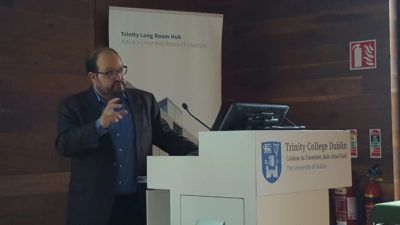Keeping a record of the retraction of research publications made it easier for journalistic coverage dissecting the infractions occurring within science publishing. “What I see that’s important, is not just coverage of individual cases, people are actually trying to put this all together. They’re filing public record requests because that’s something we’re not thinking of.” That is according to RetractionWatch, co-founder, Ivan Oransky, who started this initiative as a blog in 2010 with a single purpose in mind: making the peer-review process more transparent.
Listen to Oransky present on the peer review process
Listen to the edited version of the recording by SciencePOD.net of a recent presentation Oransky made at Trinity College Dublin, Ireland. This event, held on 20th June 2018, was co-organised by the Irish Science & Technology Journalists’ Association and the Science Gallery Dublin.
Oransky recalls the motivation that originally animated him and co-founder Adam Marcus in highlighting the mishaps of the peer-review process within academic communities. “Those of you who may be familiar with PubMed, Medline or Web of Science, you go to any of those you’ll find under 6,000 (retractions)… we [at Retraction Watch] have 3 times as many,” notes Oransky. Today, the RetractionDataBase.org site holds 17,500 retractions –and it is still growing. While retractions are rare, Oransky believes there is a screening effect attached to them.
For a sense of scale, the two countries in the world with the most retractions are China and the US. To provide an in-depth look at this, Oransky and his team compiled a leaderboard. Each of these instances are linked with a comprehensive story following the original publication.
Varieties of malpractice in peer review
Oranksy highlights a few of the problems surrounding retractions found in the peer-review community. At the time of this recording, RetractionWatch had cataloged, 630 retractions specifically due to e-mail fraud by submitting a fake peer-reviewer’s e-mail. How does this work? An academic submits a paper to a journal for submission. When the journal comes back to ask for an e-mail to reference for peer-review, rather than submitting a genuine e-mail, the academic offers a fake e-mail, which then closes the loop between him or herself and the journal. Thus, eliminating the need for a peer-review. Back in 2000, only about 5% of papers were retracted, due to e-mail fraud.

Duplication of results
Another area of malpractice occurs through duplication of results in different journals, not to be confused with plagiarism. Duplication is giving undue weight to a scientific conversation within the literature. This means when you try to conduct a scientific analysis on a topic, you’re looking at publications publishing the same thing multiple times without adding value to the topic.
All knowledge is provisional
To assume a paper should be retracted because the results aren’t reproducible is odd; but, it does occur. This shows that there is no perfect system for scholarly publishing. And that keeping a tap on retractions can help to uncover unsavoury behaviour among scientists.
Ultimately, this red flag activity leads to stronger science, as researchers are aware of the potential downsides of naming and shaming authors of retracted papers.
Enjoy the podcast!
Photo credit: SciencePOD.org

